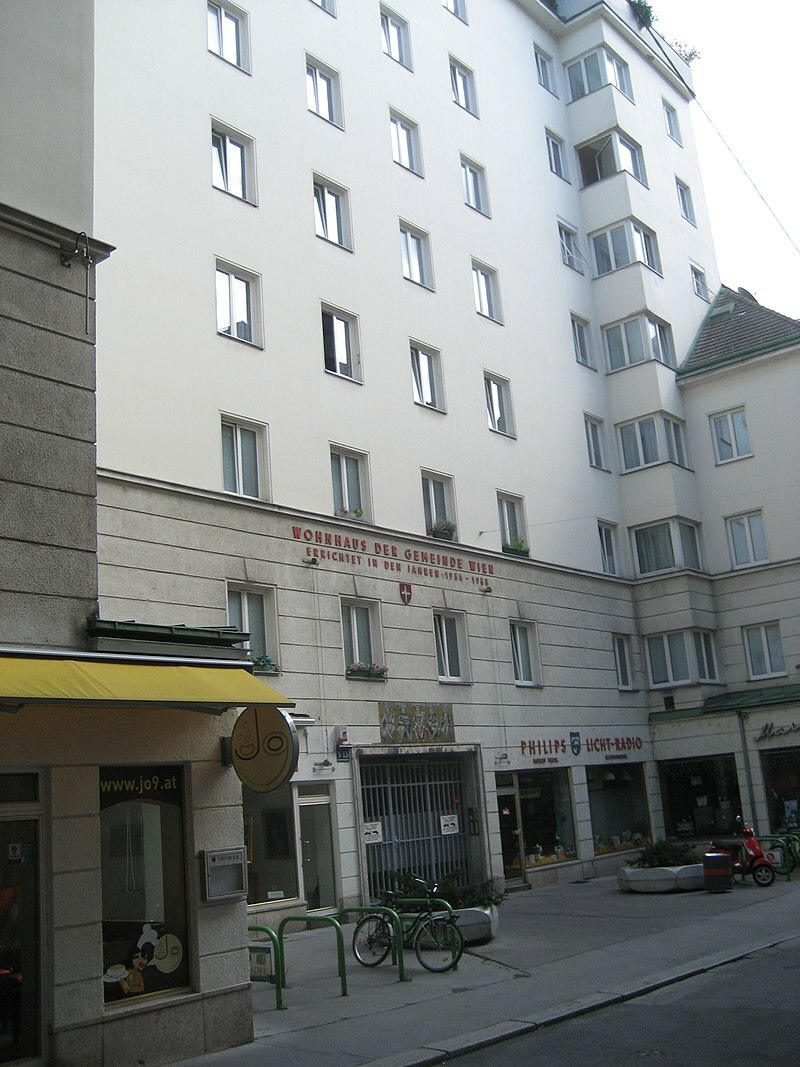
The first Gemeindebau in Vienna opened in 1924. We celebrate 100 years of fine social housing, with a tour of the six buildings owned by Stadt Wien, in the centre of our city. One of them was built in 1942, during the Nazi period, which is something unusual. It is special to still have room for ordinary people to live in the very heart of Vienna.
Eugene Quinn has been making tours of Vienna social housing since 2019, when he made a walk for Wien Museum's exhibition about 100 years of Red Vienna, looking at one house from each decade since the 1930s, all of them in Floridsdorf. His tours have been reported in Financial Times, Huffington Post, Tumblr, The Local, Wiener Wohnen, Central European University, Uni Wien, Internationale Bauaustellung, Metropole, OEAD, Yahoo Movies, Urban Future Conference, Korea Research Institute for Human Settlements, Act Now conference, South China Morning Post, Australian National Forum, W24, La Presse (Canada),
The vision, dynamism and focus on social justice of Red Vienna continues to attract worldwide attention, 100 years after the first social housing was completed, in 2024. We will look at the vision, revolutionary spirit and successes of those socialist governments.
The first elections for the Vienna City Council were held on 4 May 1919 in accordance with the universal, equal, direct and secret right to vote for both men and women. The elections resulted in a landslide victory and an absolute majority for the Social Democratic Party. On 22 May, Jakob Reumann was elected mayor. He was the first to take this office in a truly democratic way by will of the people. The problems Vienna was facing at the time were enormous: the Municipality had to cope with an empty treasury, an army of unemployed people, a tense energy supply situation, hunger, severe health problems and not least a dire need for housing.
In order to really understand the achievements of municipal housing in interwar Vienna, one has to go back some time. The housing situation at the end of the 19th century is probably best described in the words of the workers' poet Alfons Petzold: "Thirty windows, stuck together and starving for light, from each the hungry voice of poverty for comfort cried …" Life in the blocks of flats had little to do with "life per se". In 1910 almost 100,000 people were subtenants; another 75,000 were so called "Bettgänger", people who rented a space to sleep on and had basically no roof over their heads at all. In Ottakring, one quarter of the flats consisting of a kitchen and a single room accommodated six to ten people.
This housing situation also led to enormous health problems. In 1900 the average life expectancy of an unqualified worker was a mere 33 years. Of 100 children an average of 24 died during their first year of life. In his book "Wiedergeburt einer Weltstadt" (Rebirth of a Metropolis) Karl Ziak wrote a particularly remarkable sentence about this situation: "If it were possible to take houses to court, the Viennese blocks of flats would have to be put in the dock …"
Today's social housing in Vienna looks back to a long tradition. The first initiatives were taken in 1919 followed by a decision of the City Council in 1923 to build 25,000 flats from tax revenues. This resulted in a public housing model which was to achieve world fame: large multi-storey blocks with green inside courts and playgrounds and affordable flats equipped with running water, toilets and gas mains.
From 1919 to 1934 more than 60,000 flats were built creating housing space for approximately 220,000 people. The financial basis for this large-scale public housing planning was a tax system introduced by the Socialist City Councillor for Finances, Hugo Breitner, who opened up new tax resources for municipal politics. These "Breitner taxes" included a Luxury Tax, taxes on land, rents, commercial units, traffic and the Housing Tax adopted in 1922 as well as a tax on domestic servants and on luxury goods. Additional cornerstones introduced by the Viennese Municipal Administration from 1919 to 1934 were Public Health and Social Services.
We recommend this beautiful website, which explains the history, architecture and political dimensions of Vienna social housing. The right to a decent place to live is a basic human right, which is becoming increasingly unaffordable, around the world. Vienna has found an elegant solution to this problem.
Eugene will make a new tour about Vienna social housing every year, and the 2025 theme is the best Kunst-am-Bau - art created on the facade of social housing.